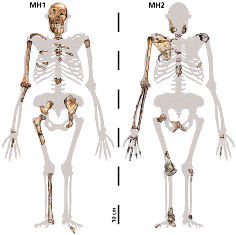
The report in Science by Berger, et al, illustrates the new species, Australopithecus sediba. The newly discovered skeletal parts are located on schematic drawings shown above.(Credit: Science)
Recent reports about skeletons discovered in South Africa have declared the “missing link” between humans and apes has been discovered. But, these reports are misleading, Michael Balter told StinkyJournalism.
Balter is former chief of the Paris bureau of Science magazine and current correspondent for Science. He wrote about the discovery in the April 9 issue of Science.
In an apparent attempt to grab headlines and to be first to report the discovery of two-million-year old skeletons, some newspapers, including the British papers The Daily Mail, The Telegraph and The Times, reported inaccurate stories that declared the “missing link” had been found.
As Brian Palmer wrote in the online magazine Slate last year, the term “missing link”–so-called creatures whose existence proves evolutionary transitions from apes to humans, for example–is often inaccurately used by media. “The research community tends to frown on the use of such language,” Palmer stated.
The report of the discovery a new species, Australopithecus sediba, written by paleoanthropologist Lee Berger, et al, was scheduled for an April 9 release in the journal Science. The embargo was in effect until April 8 at 10 a.m. EST.
“They thought they had this story ahead of time,” Balter said of the Telegraph and the Times. “They ended up putting out something that was fairly misleading, but they got there first.”
Whenever “the big discovery” claim is made, such as that attributed to Berger et al, journalists as well as the public have to be skeptical, Balter told StinkyJournalism. (You may recall that last year Balter investigated StinkyJournalism’s discovery of Jared Diamond’s inaccurate reportage in the New Yorker magazine about two Papua New Guinea Tribesmen, Isum Mandingo and Daniel Wemp, April 21, 2008).
The Telegraph was first to start writing about the discovery on April 3 with a story headlined “Missing link between man and apes found.” The story even went so far to say that the discovery “could help to rewrite the history of human evolution.”
Science journalist Carl Zimmer wrote critically of the discovery’s coverage on Slate, “Whenever scientists make a major discovery about human evolution, we get treated to a lot of misconceptions. The most popular of them all is the myth of the missing link – the idea that paleontologists are on an eternal quest for ancestors linking us directly back to earlier forms of life.”
In fact, Berger never called Au. sediba a missing link, but he did say the new species “may make a very good candidate ancestor” for the Homo genus, Christian Science Monitor reported.
MSNBC’s Cosmic Log got it right and reported April 8 that even though “it may be tempting to call these fossils a ‘missing link’ as some of the leaked news reports did earlier this week. But scientists say that’s too simplistic a term for what the bones signify.”
However, The Times’ April 4 story “Fossil from cave is a ‘missing link'” John Hawks wrote on his blog, was “an even less informative story” than the previous Telegraph piece, which he called “devoid of information content.”
The Daily Mail‘s April 5 headline also hyped that “Scientists discover ‘missing link’ between man and apes’ ” and that the new discovery could “revolutionise” theories of human evolution.
The stories in The Daily Mail, The Telegraph, and The Times don’t inform the public that there’s any debate over how the skeletons factor into evolutionary history.
Back Story
In 2008, Berger and his son, Matthew, were exploring in the Cradle of Humankind in Gauteng Province in South Africa when his son found a fossil. The fossil turned out to be the almost complete skull of an 11- or 12-year-old boy, Balter wrote in an accompanying news story in Science. An excavation turned up the partial skeleton of that boy, an adult female skeleton, and the bones of at least two others.
Researchers are still debating not just how to classify the skeletons, but also how the discovery adds to theories of how the Homo genus originated, Balter wrote.
Balter reports in Science that the research team reports “the new species may be the best candidate yet for the immediate ancestor of our genus, Homo. That last claim is a big one, and few scientists are ready to believe it themselves just yet. But whether the new hominins are Homo ancestors or a side branch of late-surviving australopithecus, researchers agree that because of their completeness—including a skull and many postcranial bones—the fossils offer vital new clues to a murky area in human evolution.”
There’s no question that the discovery is important because it is very rare to find a skull, much less a skeleton, Balter advised StinkyJournalism. While scientists continue to debate which genus the skeletons really belong among–Homo or Australopithecus– the discovery’s importance is without much controversy, The New York Times reported April 8.
Likewise, Balter told StinkyJournalism that in his reporting for Science, “even the people who were the least enthusiastic …still thought it was a pretty spectacular find.” The genus the skeletons are placed in, Australopithecus, is the same one as the 1974 skeleton called “Lucy,” MSNBC’s Cosmic Log reported. Even suggestions that the fossils could be a transitional species between Australopithecus and Homo are controversial and considered by some researchers to be an overstatement, Nature magazine wrote.
The skeletons have been named as a new hominid species named Australopithecus sediba, Berger’s report said. Sediba means “foundation” or “wellspring” in the African seSotho language. They are dated 1.95 million to 1.78 million years old.
Ivan Oransky, executive editor of Reuters Health and an NYU medical journalism professor, blogged on Embargo Watch that on April 3 at 4 p.m. British standard time, The (Sunday) Telegraph was already writing about the discovery. (You may recall as stated earlier that the embargo was in effect until April 8 at 10 a.m. EST).
Oransky questioned why Science didn’t lift the embargo in order to prevent inaccurate reports being spread.
“If the goal is to communicate the science accurately, and there’s a lot of allegedly inaccurate coverage floating around out there about a study that is already peer-reviewed and proofed, and available in PDF form to reporters, can someone please explain why the best thing to do is to wait until Thursday to release the actual study? And in the meantime, letting everyone know that breaking that embargo in order to communicate the science accurately would lead to sanctions, just like any other embargo break?” Oransky wrote.
Michael Balter told StinkyJournalism that Science decided not to lift the embargo after the UK newspaper articles as the newspapers left out where the forthcoming report would be published and the specific details of the discovery. The Telegraph, for example, wrote that experts behind the discovery have been hush-hush so far, but an announcement would be made April 8. If the stories were more specific about the discovery, he said Science may have opted to lift the embargo.
The whole point of any embargo is to allow journalists to accurately report and conduct interviews about a discovery in advance of the release, not to create a competition of who’s first, Balter said.
But, Oransky wrote that “Everyone, and I mean everyone, knew this was about the paper being published in Science,” because even though news articles didn’t attribute the report to Science, bloggers did.
Natasha Pinol, senior communications officer for AAAS/Science, wrote in an e-mail to StinkyJournalism that since no specific information can be tied as taken from the EurekAlert! Science release, there was no proof that the news outlets jumped the embargo.
Pinol writes: “There was no evidence that the news organizations who published ‘teaser’ type stories,” based their stories from the embargoed information. She explains that stories seem to be “based upon second- and third-hand sources rather than the peer-reviewed version of the fossil research described more fully and accurately in the Science Press Package.” She cautions, “Information independently obtained is beyond the reach of our embargo policy.”
UPDATE: 04/19/2010 3:03 PM EST: An unobjective source and quote has been cut.






